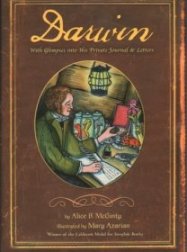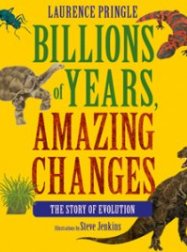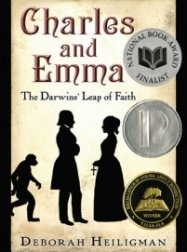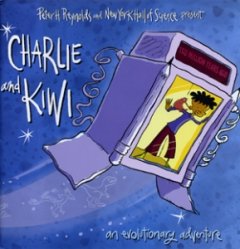 Charles Robert Darwin was born on this day in 1809. Below you’ll find a range of nonfiction titles on Darwin’s life, his theories of evolution, and his contributions to science, all recommended by The Horn Book Magazine.
Charles Robert Darwin was born on this day in 1809. Below you’ll find a range of nonfiction titles on Darwin’s life, his theories of evolution, and his contributions to science, all recommended by The Horn Book Magazine.
Primary
In Charlie and Kiwi: An Evolutionary Adventure, Eileen Campbell’s age-appropriate, scientifically on-target discussion of evolution, Charlie and his toy-kiwi-come-alive are whisked back in time. They pick up “Grandpa Charles” (a goofy cartoon Darwin) in 1860, then hop back 30 million and 150 million years. At each stop, Grandpa Charles explains individual variation within populations and natural selection. Peter H.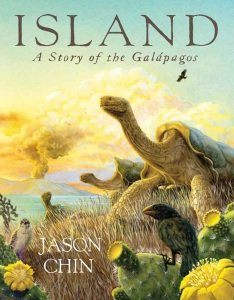 y cartoons and the kid-level humor keep the pace and tone upbeat. (Atheneum, 2011)
y cartoons and the kid-level humor keep the pace and tone upbeat. (Atheneum, 2011)
Readers witness the six-million-year development of classic biogeography example the Galápagos in Jason Chin’s Island: A Story of the Galápagos. The organizational structure — five chronological chapters — echoes the story line and underscores the ecological message. Chin’s gorgeous illustrations include sweeping double-page spreads and panels arranged to show dynamic changes (e.g., species adaptation). Back matter addresses natural selection, volcano formation/plate tectonics, and endemic species.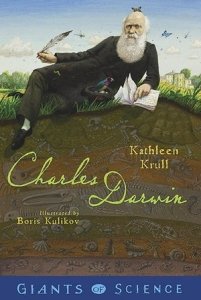 oaring Brook/Porter, 2012)
oaring Brook/Porter, 2012)
Intermediate
Author Kathleen Krull makes no bones about Darwin’s influence in Charles Darwin [Giants of Science]: “Publication day [for On the Origin of Species]…is considered the birthday of modern biology.” A useful introduction previews his life and accomplishments, acquainting readers with both the man and the scientist. Krull’s lively writing fleshes out these points, particularly emphasizing Darwin’s uncertainty about publication. Boris Kulikov’s occasional art brings humor and drama to this brisk account. (Viking, 2010)
In Alice B. McGinty’s Darwin, readers can consider Darwin from two points of view: his own and his biographer’s. The primary narrative follows the voyage of the Beagle, and nearly every spread contains a parchment-like “letter” including edited portions of Darwin’s own diary and letters. Mary Azarian’s watercolor-tinted woodcuts evoke naive art of the period. A brief author’s note and source notes are appended to this revealing work. (Houghton, 2009)
